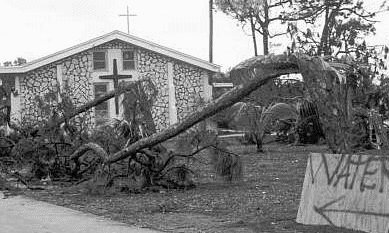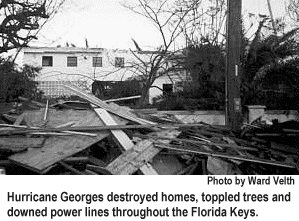General Board of Global
Ministries
![]()
UM Information
![]()
UM Reporter
![]()
Employment
![]()
Archives
![]()
Favorite Places
![]()
![]() Florida Southern College
Florida Southern College
![]()
![]() Bethune Cookman College
Bethune Cookman College
![]()
![]() FL
UM Childrens Home
FL
UM Childrens Home
![]()
|
|
Preparing for Georges’ worst pays off in Florida |
|
Photo by Ward Velth |
Despite fallen trees and no electricity,Big Pine UMC remained open as a shelter for Keys residents for more than a week after Hurricane Georges swept through the Keys Sept. 25. |
| By Tita Parham LAKELAND — Hurricane Georges was no Andrew, but from Big Pine Key to Key West, the recent hurricane packed a punch big enough to topple trees, tear apart roofs and destroy homes. With images of Hurricane Andrew in mind, church members across the state and particularly the Miami District prepared for the worst, providing the calm during the less powerful, but no less frightening, Sept. 25 storm and the cleanup days that followed. Before the storm hit, churches were on standby as American Red Cross or general church shelters. The Miami District’s Miami Lakes United Methodist Church served food to 150 Emergency Management personnel at the hurricane center in Miami, and in the Keys crews of volunteers from Big Pine United Methodist Church helped neighbors close up their homes. “You over-prepare, expecting the worst,” volunteer Roberta Swords said while waiting for church groups to drop off water and supplies at her church, Cutler Ridge United Methodist Church in south Miami, Tuesday after the storm. “People were anxious — people who had never been through a hurricane were very anxious,” she said. Swords has firsthand experience with hurricanes. For 23 years she and her family have lived in Homestead, one of the areas hardest hit by Hurricane Andrew. During that storm, Swords’ home was destroyed. She said she couldn’t help thinking Hurricane Georges could be as devastating. “You think it, then reassure yourself,” she said. “But, still, you don’t know until it’s over.” Swords and her husband left their home during the recent storm because of mandatory requirements that they remain at their workplace, the Federal Bureau of Prisons in Dade County. Their 17-year-old daughter stayed with relatives. Residents who chose not to evacuate the Keys had a place to stay, in case they needed one, at the Big Pine church, which opened as a shelter. Church members and volunteers sheltered and fed approximately 30 people each day for more than a week after the storm and cleared debris from around people’s homes so residents could safely return to them. Marie Nattrass, 89, didn’t want to leave her home, but admitted she was glad she went to the church. She says her visiting nurse, longtime Islamorada resident Barbara Hotchkiss, convinced her to leave. The storm blew the shutters of Nattrass’ home, broke a window and flooded the house with about five inches of water, according to Hotchkiss. "I’ve been through so many of them [hurricanes], I didn’t think it would be that bad,” Nattrass said. “I’m glad I came in — in a way.” Nattrass has lived in the Keys for 22 years. She hadn’t been back to her house since going to the church Saturday, so she wasn’t sure what to expect, and she doesn’t have insurance. One woman staying at the shelter was told Monday after the storm that her home was destroyed. Some of the shelter’s visitors were already homeless and receiving help through the church’s homeless ministry. Everyone pitched in to help, regardless of their situation. Phillip Buck and a friend, William Bailey, traveled from Oregon to the Keys specifically to help hurricane victims as part of what Buck calls a guerrilla ministry of the Nazarene Church. They travel from location to location doing mission projects, “wherever there’s a need,” Buck says. Buck helped coordinate the church’s work teams, spending his days getting trees off roofs, getting cars started, “running a saw all day,” he said. He also took the woman who had lost her home to see the house for the first time since leaving it. He says she was devastated. Although people were in a state of shock, he says they were in fairly good spirits: “They are banding together, getting to know their neighbors, neighbors they didn’t know at all before the storm.” It has been a real community and church-wide effort, according to the Rev. Richard Derreth, the Big Pine church’s pastor. He said the Baptist church next door cooked food, the Lutheran church down the street delivered food and an American Red Cross response vehicle provided assistance from the Baptist church. “It’s coming together. Whatever needs to be done is being done,” he said. “We even had someone in here [the shelter] cutting hair. Street entertainers who lost their boat played the guitar last night.” Members of the conference’s United Methodist churches responded immediately, donating food and water, supplies, chain saws, and generators. The Big Pine church, like the rest of the Keys, was without electricity for at least a week. Water was finally restored the Monday after the storm. United Methodist churches and parsonages suffered minor damage. Churches have also begun sending work teams to the area. A United Methodist Volunteers in Mission (UMVIM) group from First United Methodist Church, Brooksville, was the first to arrive at the Big Pine church Sept. 28, just a day after residents were allowed to return home. Maria Malakoff, volunteer UMVIM coordinator for the Miami District, is working to recruit as many teams as possible. “The reason we are a success is because we are coming together,” she said, adding that she volunteers because she “would rather help people. I get more out of it than I give.” She says it also keeps her from worrying about her mother in Cuba, whom she hadn’t heard from in five days, since the storm hit there. Swords took a day off from work to help out and says it’s a way for her to repay all the people who helped her and her community during Hurricane Andrew’s relief efforts. "UMCOR [United Methodist Committee on Relief] was here with supplies, helping the community,” she said. “It was nice knowing there was an agency like that. The United Methodist Church does a lot.”
Through local United Methodist churches, UMCOR has been working for nearly 60 years to
provide assistance to individuals and families around the world who don’t qualify for
help from other disaster organizations. The group also works closely with other
denominations and volunteer organizations, such as the American Red Cross and Salvation
Army, as well as state and local governmental agencies. It has the reputation of being the
last to leave a disaster area, providing assistance for up to two or three years. Congregations are being asked to form work teams and gather supplies. Canned goods may be delivered to the United Methodist Depot, 3370 53rd Terrace, High Springs. Groups should call before making a delivery (904-454-7775). Members were also asked to give money to the relief efforts, and churches were asked to
collect a special hurricane relief offering Oct. 4. Contributions should be made to the
Florida Conference Treasurer and designated to “UMCOR Advance Special #982515”
to help either the islands outside the United States or the Gulf Coast states affected. |


 Disaster co- ordinators for the Florida Confer- ence requested
$10,000 from UMCOR, the disaster-relief arm of the denomina- tion, to help with the relief
efforts.
Disaster co- ordinators for the Florida Confer- ence requested
$10,000 from UMCOR, the disaster-relief arm of the denomina- tion, to help with the relief
efforts.